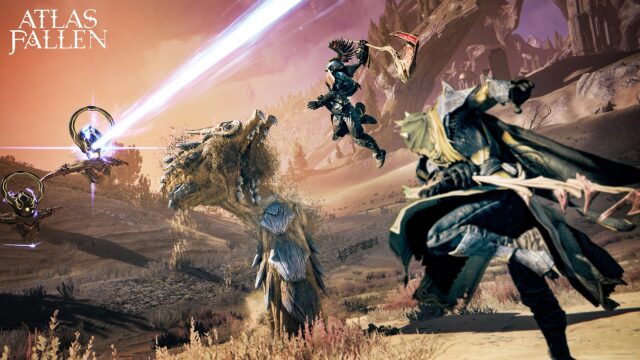Atlas Fallen Review
Toes in the Sand
After being first on the scene to make games heavily-inspired by From Software’s Dark Souls series, Deck13 Interactive has decided to cast aside that lineage for its newest outing, opting instead for an entirely new experience. Freed from the confines of Souls DNA, the company found itself creating a miniaturized open world game that pulls from character actions titles as sources of inspiration. The result is Atlas Fallen, an action RPG that is refreshing and frustrating at the same time. The game has interesting ideas and only manages to land about half of them. Though admirably attempting to blend more expansive action and some cool movement options, nothing ends up being tuned quite well enough to bring it all together.
For centuries, the Sun God Thelos has ruled over the land of Atlas. With the beating hot sun bearing down on the world, its inhabitants are gathered up and used as labor to mine Essence, a substance that empowers the gods. While traveling with a caravan en route to a new job, the player stumbles across a magical gauntlet that houses a spirit within. With the aid of this spirit and the power of the gauntlet, players find themselves caught up in a rebellion with the gauntlet presenting an opportunity to overthrow Thelos. Despite some decent world-building ideas and visual aesthetics, the story of Atlas Fallen largely falls flat. It’s a pretty stock tale of a ragtag group toppling a seemingly all-powerful empire and what’s more most of the game’s performances are stilted and uncompelling. It’s a shame that these sorts of issues put a damper on what could be good.

The Wraiths have some pretty fun designs, though players spend a lot of time fighting the same ones over and over again.
What does come across as good, if only just, is the game’s combat. Atlas Fallen‘s combat is an offensive-focused affair with a universal parry. The primary enemies in the game are Wraiths, extensions of Thelos’ power, and players will spend much of the game attacking and breaking apart these creatures piece by piece. Larger Wraiths’ body parts can be separately targeted, increasing the rewards for defeating the enemy with every piece broken. As players attack enemies, they will fill the Momentum Gauge, the primary combat resource. The Momentum gauge is broken into three tiers that as the gauge increases confer new benefits and special moves to the player. Momentum can also be spent all at once to use one massive attack, one that has the chance of defeating an enemy outright. Customizing the Momentum gauge is the main way players will customize their playstyle, and the variety of abilities is staggering, with constant new options being unlocked throughout the game. The payoff is that the player becomes more susceptible to damage the higher the Momentum gauge goes, so players are left with an interesting decision as to when push Momentum further or play more defensively. It’s a clever system, kept from greatness by a few drawbacks.
Most glaring is the lack of impact with many of the attacks. For a game where the player will be attacking with high frequency, there’s a distinct lack of feedback that renders the attacks feeble-feeling. Lending to this feeling is how weightless the character is. Aerial combat is not only easy to initiate but easy to keep going indefinitely, meaning it becomes easier to just attack mindlessly with little concern of retaliation. Airborne enemies become more common as the game goes on, but the length of time the player can spend off the ground ceaselessly attacking can feel excessive. There also isn’t a wide variety of weapons with only three to choose from and only two able to equipped at a time. They also really only affect the character’s basic attacks, as special attacks on the Momentum gauge are weapon agnostic. This is also a game where parrying is a necessity, which isn’t inherently a bad thing but does mean the options for defensive play feel more limited.

Fights can become quite hectic, as larger Wraiths will periodically summon in more smaller ones to try and overwhelm the player.
Outside of combat, Atlas Fallen operates similarly to a standard open world game, albeit with truncated maps and some cool traversal options, namely a double-jump and air dashes. Along with wandering Wraiths, the four main maps of the game are filled with various activities and side quests. Some of these are dull, like having to slowly follow wild animals until they lead to treasure, but many of them actually engage with the game’s movement mechanics in fun ways. Scaling buildings, intuiting a series of jumps to get to a hard to reach area, and racing while needing to find ways to circumvent the environment in a timed manner are all surprisingly fun to do and make the maps feel a lot more vertical than they first appear. Ironically, the same weightlessness that robs the combat of some “oomph” actually helps in making the platforming work. It’s far from a precision platformer, but there’s a good bit of entertainment to be gained from exploring the map and the game’s size is manageable enough that it never feels like a huge detour.
Atlas Fallen‘s RPG elements are not very prevalent. Beyond the customizing the Momentum gauge, the only choices the player makes towards progression is in what armor they wear and the perks they unlock. Armor is not a very common reward in the game and what it mostly provides are stat boosts that push strengths one way or another. Each armor set can be upgraded twice and its worth it to do this as it not only increases their stats but unlocks new passive abilities and grants one Perk point for each upgrade. It would be nice if there was more versatility to the armors but instead it’s easier to just pick the option with the best stats and ignore the rest. Perks are passive abilities that mostly just make certain things easier, such as gaining more materials to craft and upgrade abilities or making Momentum fill quicker. The system is totally fine, except that by the end of the game odds are that most of the available Perks will be unlocked meaning its less a decision of which Perks to pick and more in what order to pick them.
The world of Atlas has a strong visual aesthetic and some great directorial decisions, such as an omnipresent Watcher, a large manifestation of Thelos, dominating the skyline. It ends up acting in a similar manner to Hyrule Castle in Breath of the Wild or the Erdtree in Elden Ring, in that its helpful for gauging where the player is on the map in relation to it. Unfortunately, Atlas Fallen is also a bit rough in terms of performance. Framerate drops were common, and there were several times where the game would lock coming out of standby. Nothing that resulted in a ton of lost time but present all the same. The music in the game is serviceable but ultimately forgettable.
I wish that I could call Atlas Fallen an overlooked gem from an overstuffed year of games, but it doesn’t quite reach that bar. It’s not an unsalvageable project and with some refinement in the gameplay, a stronger script, and some better performances this could be a solid action RPG. I didn’t even have a chance to try out the game’s co-op, which could potentially go some ways to opening up the game’s RPG elements. That doesn’t change that what is there is a fine attempt at something new but one that never fully rises to the occasion.
Disclosure: This review is based on a free copy of the game provided by the publisher.


Interesting combat flow
Neat visual aesthetic and setting
Stock story with poor vocal performances
Game performance leaves a lot to be desired
Loose controls makes combat lack oomph







Recent Comments